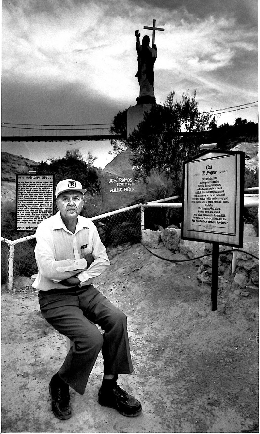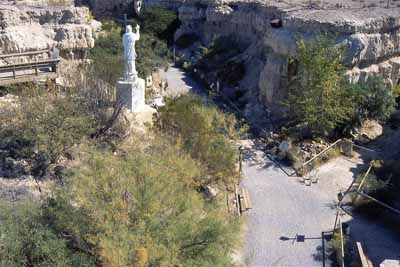

Roland Wiley's Cathedral Canyon Las Vegas. Mr. Wiley built a cathedral in the desert after a near-death experience. |
Roland Wiley Road honors Cathedral Canyon creator. He first felt these "subconscious instincts" when he was hospitalized with tularemia, aka rabbit fever, and had a near-death experience. |
 |
|
August 2, 2011 - Reported in [lvrj.com]. One of the notable men who helped craft Las Vegas was an attorney named Roland Wiley. A small street in the Summerlin area, Roland Wiley Road, is named for him. The north-south road is west of the International Church of Las Vegas, 8100 Westcliff Drive. Born in Avoca, Iowa, in May 1904, Wiley earned a law degree from George Washington University in 1927. Two years later, he set up a law practice in Las Vegas, back when it had no streetlights. It was an era before air conditioning, and he would sleep outside his Fremont Street house in the summer. It was that "or you'd soak your sheets with water and get into bed," he once told a newspaper. "The sheets would be almost dry right about the time you'd fall asleep." In 1936, he bought a 14,000-acre ranch outside Pahrump. He also acquired land in Las Vegas, part of it where the Gold Coast now stands on Flamingo Road, acreage he would sell in 1946 to Hoot Gibson, a cowboy film star. The price: $65,000. In 1939, Wiley was elected Clark County district attorney but left after one four-year term to concentrate on his lucrative law firm. Perhaps he should be remembered for more ethereal work begun in the 1960s. Wiley "built" a cathedral in the desert near Pahrump. It was called, fittingly, Cathedral Canyon. The cathedral walls were built by Mother Nature. The roof was the sky above.Interviewed for a newspaper article in 1993, he was asked why he wanted to build it. "I think everyone is possessed, subconsciously, by certain impulses, you know," he told the reporter. "They think we're always led by what we see, but we're pushed from behind ... sometimes, by instincts that we're totally unaware of." Wiley said he first felt these "subconscious instincts" when he was hospitalized with tularemia, aka rabbit fever, and had a near-death experience. The result was a canyon rim flanked by artistic street lamps. A suspension bridge -- the first upgrade he put in -- spanned it, and a metal stair access awaited those who might one day come to worship. Benches filled the base of the canyon. The whole thing was rigged for sound and fully lighted. Some lights were behind stained glass windows set into natural canyon wall niches. Wiley even installed a paved road for easier access, which cost him $12,000. Mark Hall-Patton, administrator for the Clark County museum system, said he never met Wiley but had "bounced into him" in his research. "I found him to be one of those unsung characters in local history ... he was quite a character," Hall-Patton said. Wiley began inviting visitors to the remote Nye County canyon in the early 1970s, the same time nondenominational religious services began there. As many as 4,000 people a month attended. His upgrades have since been destroyed; by whom is unknown. A [youtube video] shows it before it was destroyed. Comments posted to the site include this one from "Mary": "We used to ditch school at Silverado High back in the mid 90s and just go there to hang out and see what people have left behind. We lost a friend in high school and that is where we all went to pay our respects. I am very disheartened to hear that people have vandalized it over the years. What disrespectful jerks it must take to trash such a serene and eclectic place like the canyon." "Bob" posted: "I visited Cathedral Canyon by accident today (08-01-07) and it looks like most of it was destroy (sic) a few years ago. Currently there is; no bridge, no signs, and the only statue left is the one of Jesus and it is missing its head." Wiley died in August 1994. He was 90. |